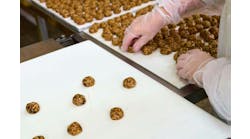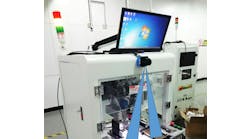As spring and summer arrive here in the northern hemisphere, we find ourselves hopeful that the long pandemic is showing signs of waning. The warm weather does wonders for the soul. The signs of new growth, the return of migrant birds, the fresh smells on the breeze can’t help but lift the spirits. Parallel to the growth of hope, we are finally seeing signs of the economy rebounding from the long slumber and, with it, the awakening of a long-suppressed manufacturing sector.
The years-long pandemic has severely impacted the available workforce and forced many manufacturers to leap into automation with the intent to make up for the lack of people to put on the production line.
Also read: Hurco Manufacturing accelerates machine tool assembly checks
A boon to those who make and/or distribute automation, the proliferation of automatic equipment has introduced a hidden risk in that there aren’t people on the line to inspect the products being produced. The hard-working people at the end of our lines did more than put cartons in cases or cases on a pallet. They were a built-in quality control point.
Grabbing a bottle with a tamper band on it, looking at the package, squeezing the bag of product, handling a case—all of these everyday events had the added benefit of a final check of the product before it was sent off to a warehouse and, eventually, out to the final user.
Automation has made up for the diminishing workforce but left us with the challenge of making up for the human element now missing from the production line.
Methods of inspection have been around for years, but with automation—particularly end-of-line automation—taking a significant leap forward in the past 36 months, machine designers are forced to incorporate more of these techniques into their products.
Over the years, inspection tended to be a periodic function. Quality technicians would walk about the plant and randomly select sample products for spot inspection to validate the process.
Off-line inspection affords the ability to take time with the evaluation in a non-production environment. Multiple tests could be made without interrupting the flow of production. The challenge is how to accomplish this while the product is moving down the line. The issue hindering the presence of people on the production line is also impacting the availability of people in the quality assurance department.
It’s important to take a moment to think about the challenge presented, rather than plunging into the murky waters. Sometimes we jump quickly into high-tech solutions when simple ones would suffice.
A good example is the tamper band mentioned previously. Tamper bands are rings of plastic that are sealed around the lid of a bottle to ensure that the cap is secure and hasn’t been removed since being produced. This device is an assurance to the end user that the product in the container is safe to use or consume.
The first time I encountered a tamper-band inspection, it involved a vision system. It was an earlier version of a vision system with only a few tools available to execute the inspection. One product was in a yellow bottle with a blue cap, while another version had a white cap. The tamper band was applied by a machine that indexed a length of plastic tube, cut it to an appropriate length and blew it onto the top of the bottle with a blast of air.
The bottle then moved through a heat tunnel, which shrunk the tamper band to fix it to the top of the bottle. The inspection system would then examine each bottle to make sure that the tamper band was present and that it was on the bottle sufficiently to seal over both the lid and the bottle itself.
As this was an early version of a vision system, the limited tools made it a challenge to check for the tamper bands. The bands, at the time, were clear plastic with some black lettering on them. This created a challenge because a simple contrast test had to be specific to a blue lid versus the white lid.
As one might imagine, the black letter on blue was difficult to expose sufficiently to assure a positive result. Various changes were attempted to enhance the inspection. The lettering was changed to solid diagonal lines. This worked better but still had challenges because the color of the banding might show up well on the blue top but not the white top. The same goes for the yellow of the bottle itself.
Further complicating this example, the product was moving down the line at a speed of more than 100 bottles per minute, so there wasn’t much time to take a picture, evaluate it and make an accept/reject decision in time to kick the bottle off the line without impacting the bottle before or after it.
The system worked, but it required a lot of babysitting and a very stable platform to make sure that the bands were all the way down on the bottle.
A couple of years ago, I was working with a vendor who showed me a sensor that picked up the ultraviolet spectrum. This product is little more than a fancy photo-sensor, and, as such, is much easier to deploy and support. It is simply looking for ultraviolet ink on a product. Since it is a small package, mounting two or more of these sensors would be sufficient to detect the tamper band on both the lid and the bottle.
Unfortunately, the bottled product is no longer at my facility, but it would have been a great solution to this challenge. The point here is that, while the default thought would be to go with a vision system, sometimes picking out a unique property of the product provides a simple solution.
Other examples of sensors that could be used instead of a vision system are the new breed of photo sensors that can sense color, contour and texture of a substance. They can even adapt to a changing environment.
For example, we use a sensor that detects product dropping from a volumetric filler into a horizontal packager. The product drop tends to create static on the down tube and product will build up on the inside and outside of the relatively clear tube. It eventually becomes opaque, and the ability to detect product can be inhibited.
A normal photo sensor—send-receive or horseshoe—would start out working well with the product but quickly diminish as product builds up. We would normally cut a hole in each side of the down tube to shine the send-receive photo beam through, but buildup would limit the amount of time before the tube and sensor would prevent detection.
With this new generation of sensor, the beam can shoot straight through the tube without cutting holes in it. That means there isn’t a point where product can be collected to block the beam.
In addition, the sensor uses smart technology to continue to work as product buildup happens on the inside of the tube. The sensor looks for a change in the intensity of the received light source and provides an output based on that change of state.
While the tube eventually needs to be cleaned, the amount of production time is greatly enhanced because of the change-of-state technology. As long as we can detect a change in state, we know that each pouch is receiving a drop of product.
Another example is a new generation photo-sensor that can be used for complex eye-spot detection. It used to be that an eye-spot on a piece of film was either white on a black background or black on white. The contrast made it much easier to correctly identify the spot on film.
However, one thing that negatively impacts the application of this technique is the presence of ambient light where the spot inspection takes place. This new type of sensor can be adjusted for a variable luminosity to compensate from the shiny film. It can also employ texture recognition to further enhance the ability to correctly identify the object.
One can teach the detection point and then move the object around in the light beam to teach it the variance that might exist due to texture or reflective properties. The great part is these techniques are available in the same sensor product, making it much more effective in a variety of applications.
In defense of vendors who make vision systems, there are specific applications where only a full-on vision system will correctly inspect a product for compliance. The sensor applications mentioned are worth a look for situations where detecting just the presence of the product is necessary.
Not to lose out on these opportunities, you will find that many of the vendors who have vision systems as their first solution will also have a much simpler solution. Simple usually means less costly, and it is certainly worth asking a few questions when you call your vendor in to have a look at your application.






